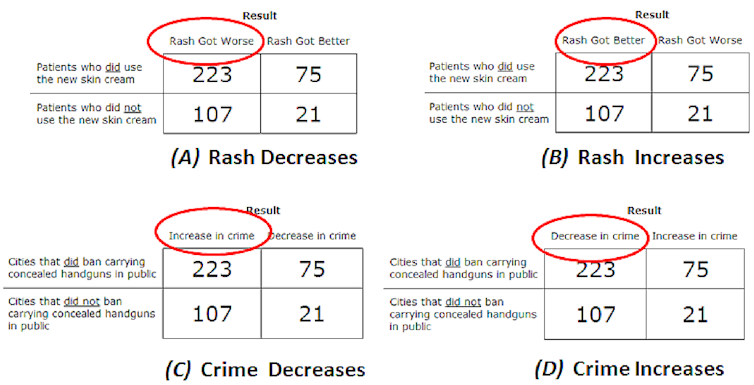Any frequent user of social media is probably aware of the tendency for both sides of politics to view the other as fundamentally immoral and ignorant.
Interestingly, longitudinal data suggests that political polarisation is intensifying, at least in the United States, with the recent US election seeing partisanship reach an all-time high.
One important contributor to this phenomenon is confirmation bias: the tendency to seek or interpret evidence as supporting our pre-existing beliefs, regardless of whether it really does.
There is also research showing that confirmation bias is particularly active when the evidence at hand threatens the validity of our political worldview.
An experiment on bias
To illustrate this phenomenon, Yale University’s Dan Kahan and colleagues ran an experiment to see how our political biases influence the way people interpret hard data.
They presented participants with two tables of made-up data about the link between gun control and crime rates. The numbers in both tables were identical; the only difference was the labels were switched. One referred to the efficacy of a fictional skin care cream and the other referred to the effect on crime of carrying handguns (see below).

What they found was rather surprising. When the data contradicted a participant’s political beliefs, they were much less likely to interpret the data correctly. Indeed, most participants even claimed the statistics supported their pre-existing belief!
This effect was seen in similar amounts both for self-declared progressives and conservatives, which debunks the idea that one side of politics is more prone to bias than the other.
You might think that someone with a better grasp of numbers might have some immunity to this bias. But the study also found that ideological biases in the interpretation of statistics were even more pronounced for participants with better numeracy scores.
This raises the possibility that people who are more intelligent may tend be more biased as they use their superior cognitive capacities to more effectively mould their interpretation of the evidence to fit their worldview.
Motivated cognition in Australian politics
Although Kahan’s study was conducted in an American context, real-world examples of politically-motivated interpretations of statistics can be seen in Australian political discourse.
Take the recent debate over comments made by Immigration Minister Peter Dutton about Lebanese immigration. There are two statistical heuristics that could be considered in deciding the level of terrorist threat posed by Lebanese-Australians:
The proportion of people involved in terrorism-related activities who are of Lebanese vs. non-Lebanese descent, and
The proportion of the total Lebanese-Australian population who are involved in terrorism-related activities vs. those who aren’t.
Conservatives tend to emphasise the former and imply that this statistic highlights a problem with Lebanese culture.
On the other hand, progressives emphasise the latter, that the vast majority of Lebanese-Australians disavow terrorism and that terrorist activity represents a disturbed minority acting against the values of the wider Lebanese-Australian community.
However, both progressives and conservatives will flip which statistical heuristic they use when it suits their ideology.
For instance, when it comes to discussion about the causes of sexual assault, many conservatives condemn what they perceive as a generalised demonisation of men for the actions of a few going against mainstream social norms.
On the other hand, progressives tend to focus on the fact that men are more likely to engage in sexual violence than women, and tend to place the blame on aspects of mainstream Australian culture.
Why the inconsistency?
One way to understand the different perspectives taken by progressives and conservatives is to look at their worldview, which represents how they understand the world to work, and their place in it.
Conservatives tend to have a worldview that seeks to justify and preserve a “superior” majority culture that is threatened by “inferior” minority cultures.
Therefore, in an Australian context, they tend to focus on the large proportion of terrorism offenders who are Lebanese (strategy 1 above), and emphasise that only a small proportion of Australian men engage in sexual violence (strategy 2).
Conversely, progressives tend to reject the idea that mainstream Western culture is inherently superior. They are thus more averse to criticisms of minority cultures and more receptive to statistics that imply issues with the dominant majority culture.
So they emphasise the small proportion of Lebanese Australians who are involved in terrorism (strategy 2), and criticise mainstream Australian culture for the fact that men are the perpetrators of most sexual violence (strategy 1).
It must be noted that the existence of political biases does not mean that both the conservative and progressive positions on any particular issue are wrong. The fact that people on both sides of politics demonstrate motivated reasoning does not imply a kind of compromise centrism where the truth always lies between a conservative and progressive viewpoint.
What it does demonstrate is the mental gymnastics we will undergo to deflect threats to our worldviews.
For me, an awareness of this tendency for bias promotes humility, openness to different opinions and empathy for political opponents; for they are as much trapped in their mind as I am in mine.

